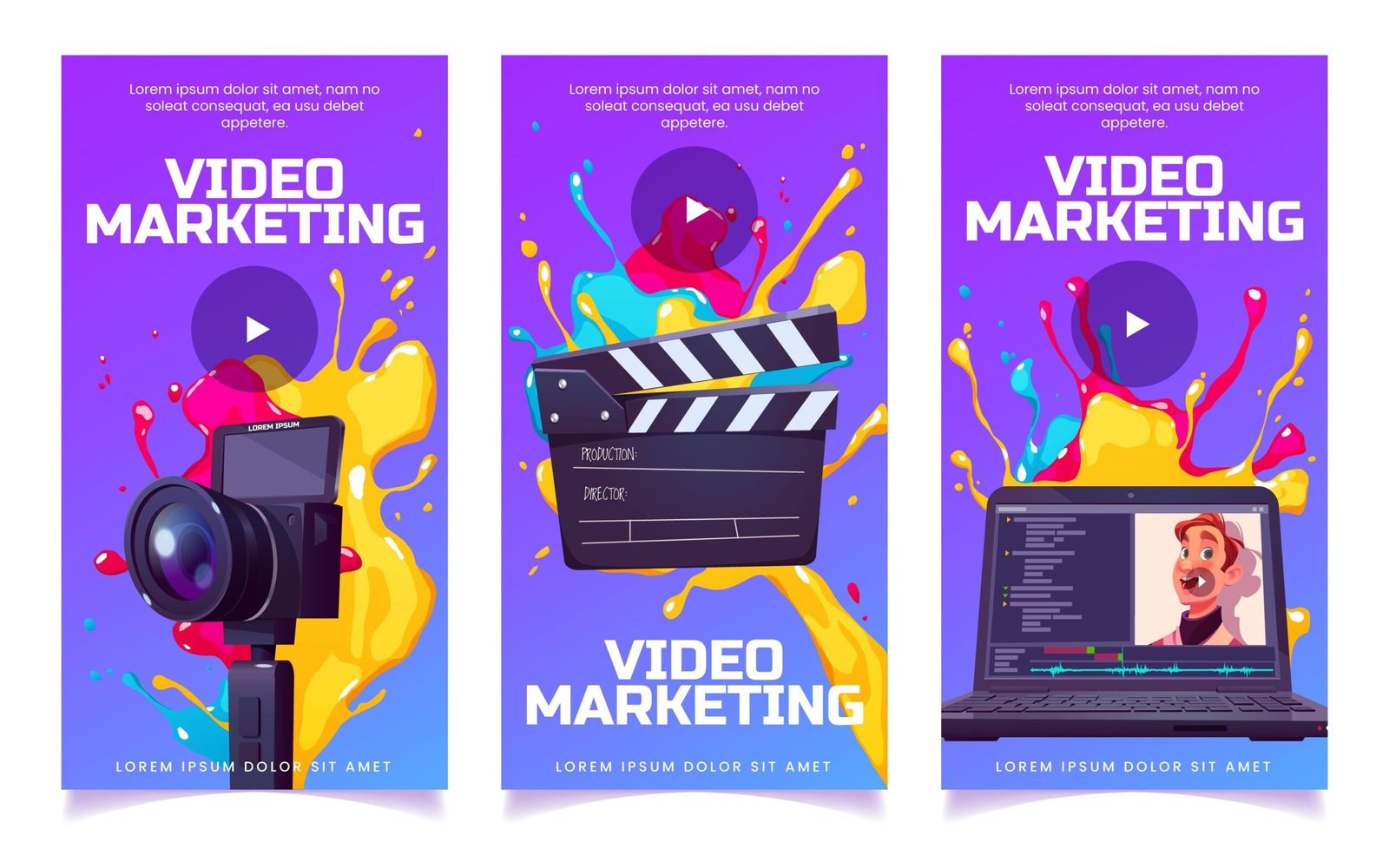Introduction to B2B Marketing in 2025
The landscape of B2B marketing is undergoing significant transformations as we approach 2025. Businesses are recognizing the necessity of adapting to new consumer behaviors and technological advancements. In this context, video content has emerged as a pivotal component of B2B marketing strategies, capturing attention and fostering deeper connections with target audiences. The rise of video-first marketing reflects not only a shift in content consumption preferences but also the increasing demand for engaging and interactive formats that resonate with professional audiences.
Over the years, B2B marketing has evolved from traditional promotional tactics to more dynamic and multifaceted approaches. Companies are leveraging video to showcase their offerings, educate potential clients, and facilitate meaningful conversations. With the growing prevalence of remote work and virtual collaboration, video communication has become an essential tool for marketers aiming to bridge the gap between businesses and their clients. This shift signifies a broader trend where visual content is prioritized to enhance understanding and retention among audiences.
Additionally, the integration of live streaming, webinars, and personalized video messages is shaping the B2B marketing landscape. Such interactive experiences not only promote engagement but also foster an environment where prospects feel more connected to brands. This trend emphasizes that B2B marketers must evolve their strategies to include more video-centric initiatives, tailoring their content to meet the preferences of modern businesses.
As we look ahead to 2025, the implications of prioritizing video content in B2B marketing are profound. Brands that successfully implement video strategies will not only enhance their visibility but also create more impactful connections, leading to better customer relationships and increased conversion rates. By embracing this video-first approach, businesses can differentiate themselves in an increasingly competitive market, establishing a robust foundation for future growth.
The Rise of Video Content in B2B Marketing
In recent years, the landscape of B2B marketing has undergone significant transformation, largely facilitated by the rise of video content. As businesses seek more effective methods to engage their target audiences, video has emerged as a powerful tool. According to recent statistics, 83% of marketers report that video content has aided in generating leads, while over 80% state it has increased conversions across various platforms. These figures illustrate that video content is not merely a trend but a vital component of successful marketing strategies.
One of the key reasons for the growing prominence of video content in the B2B sector is its ability to enhance engagement. Studies reveal that video content is likely to be shared 1,200% more than text and images combined. In a digital environment characterized by information overload, this substantial increase in shareability demonstrates the efficacy of video in capturing attention and fostering interaction. Companies that incorporate video into their marketing initiatives are likely to see an uplift in customer retention and loyalty as audiences are more inclined to engage with visually appealing content.
Moreover, video serves as an effective medium for the stories that brands wish to tell. A compelling case study worth noting is that of a leading software provider which leveraged customer testimonial videos to highlight their successful implementations. This approach not only solidified the brand’s credibility but also generated significant interest from potential clients. In this regard, video content plays a dual role in B2B marketing: it drives conversions while simultaneously elevating brand awareness and reputation.
Given its substantial impact on engagement and conversion rates, video content will undoubtedly remain a cornerstone of B2B marketing strategies moving forward. Marketers must remain attentive to emerging trends in video content creation and consumption to leverage its full potential in a competitive landscape.
Emerging Video Formats for B2B Marketing
The B2B marketing landscape is undergoing a transformative shift, particularly with the emergence of innovative video formats anticipated to dominate by 2025. Among these formats, live streaming stands out due to its ability to foster real-time engagement and create authentic connections between brands and their audience. Live streaming can facilitate product demonstrations, Q&A sessions, and behind-the-scenes content, allowing businesses to present themselves transparently and dynamically. This interactivity not only enhances audience engagement but also fosters trust and loyalty.
Another video format gaining traction is the 360-degree video. This immersive experience enables viewers to explore a virtual environment, providing enhanced storytelling opportunities for B2B companies. Organizations can utilize 360-degree videos to showcase their products, services, or even events, thereby allowing potential clients to engage with content in a more interactive manner. As businesses continue to explore creative ways to present information, 360-degree videos emerge as a powerful tool to captivate attention and convey complex concepts effectively.
Short-form content is also expected to gain significant momentum in B2B marketing strategies. As attention spans dwindle, concise videos that deliver core messages quickly are becoming essential. Platforms like TikTok and Instagram Reels have highlighted the importance of brevity and creativity within video content. B2B marketers can leverage short-form videos to create teasers, quick tips, or brief insights, ensuring that they communicate valuable information without overwhelming their audience. This format encourages frequent content updates and helps maintain brand visibility in a crowded marketplace.
Utilizing these emerging video formats in B2B marketing not only enhances engagement but also aligns businesses with contemporary consumption trends. With their potential to create immersive and interactive experiences, live streaming, 360-degree videos, and short-form content are set to redefine how businesses connect with their audiences, ultimately driving engagement and conversions in the years ahead.

Personalization through Video Marketing
As businesses increasingly recognize the significance of tailored communication, the role of personalization in video marketing within the B2B sector is becoming pivotal. In 2025, the use of data-driven insights to produce personalized video content is anticipated to grow substantially, enhancing engagement and driving meaningful connections between brands and their audiences. Personalization allows companies to cater to the unique preferences and needs of individual clients or target segments, making video marketing a powerful tool for fostering relationships and increasing conversion rates.
To harness the power of personalization, B2B companies must first focus on collecting and analyzing relevant data. This includes understanding customer demographics, behaviors, and preferences. By leveraging analytics tools, businesses can gain insights into what resonates most with their audience. Equipped with this information, marketers can create tailored video content that speaks directly to specific pain points or goals of their clients. For instance, a technology firm may produce a video that addresses the unique challenges faced by an industry sector, showcasing how their solutions effectively resolve those issues.
Moreover, the use of dynamic video content—where elements of the video change based on viewer data—will likely become more prevalent. This approach not only enhances the viewer’s experience but also increases the likelihood of engagement and response. Personalized video messages, targeted ads, and follow-up content can ensure that the communication is relevant and timely, creating a more engaging user experience. As companies navigate the evolving landscape of B2B marketing, those who prioritize personalization in their video strategies will likely see significant improvements in user engagement and overall effectiveness of their marketing efforts.
Integrating Video with Other Marketing Channels
In the rapidly evolving landscape of B2B marketing, the integration of video with other marketing channels is becoming an essential strategy for success. As organizations strive to engage their audiences effectively, implementing a cohesive marketing approach is critical. Video serves not just as a standalone medium, but as a powerful tool that can amplify the impact of various marketing channels, including email, social media, and content marketing.
One of the foremost strategies involves leveraging video within email campaigns. Studies show that integrating video into emails can significantly increase open and click-through rates. Marketers can enhance their message by including a video thumbnail in the email, encouraging recipients to engage with the content in a dynamic format rather than static text. By providing informative and compelling visual content, businesses can better capture the attention of recipients, leading to higher engagement and conversion rates.
Social media platforms have become increasingly video-friendly, making them ideal for integrating video content. Each social platform employs unique algorithms favoring engaging, visual material. For instance, businesses can utilize Instagram Stories, Facebook Live, or LinkedIn Video to deliver compelling narratives or product demonstrations that resonate with their audience. Different formats such as live streams, short clips, or long-form videos allow brands to tailor content to the preferences of their target demographic, thereby increasing brand visibility and fostering a deeper connection with potential clients.
Furthermore, within content marketing, video can be utilized to enhance traditional blog posts or articles. Incorporating explanatory videos or interviews with industry experts can enrich the textual content, offering additional insights and establishing authority. This dual approach not only improves the user experience but also increases the time spent on pages, which can positively affect search engine rankings.
In conclusion, integrating video with other marketing channels is essential for creating a cohesive and effective B2B marketing strategy. By combining video with email, social media, and content marketing, businesses can enhance audience engagement and drive better results in 2025 and beyond.
The Role of AI and Automation in Video Production
In recent years, the landscape of video production in the B2B space has been significantly transformed by advancements in artificial intelligence (AI) and automation technologies. These innovations have streamlined various aspects of the video creation process, making it both faster and more efficient. AI-driven tools are now revolutionizing how businesses approach video content, enabling them to generate high-quality videos with reduced effort and resources.
AI algorithms can now analyze vast amounts of data, allowing marketers to tailor their content to meet specific audience preferences effectively. One prominent application is in the realm of video editing. Automated editing software can intelligently select the best clips, apply transitions, and synchronize audio, thereby minimizing manual intervention. Such automation not only accelerates the editing process but also ensures a level of quality that may be challenging to achieve manually, especially for smaller B2B companies with limited resources.
Furthermore, AI technologies are enhancing the distribution of video content. By leveraging machine learning, platforms can predict which segments of the audience are most likely to engage with specific types of videos. This capability facilitates more precise targeting, helping B2B marketers optimize their outreach efforts. Additionally, AI tools can automatically generate captions or translate video content, making it accessible to a broader audience regardless of language barriers.
Beyond editing and distribution, AI is also contributing to the creative process. For instance, some platforms utilize AI to generate scripts or provide insights into trending topics, helping marketers develop relevant and engaging content. The combination of automation and AI-driven analytics allows B2B marketers to be more strategic and data-driven in their approach, ultimately leading to better engagement rates and return on investment.
As the adoption of these technologies continues to rise, the integration of AI and automation in video production will undoubtedly shape the future of B2B marketing, making it crucial for companies to stay abreast of these developments to remain competitive in a fast-evolving landscape.

Measuring the Effectiveness of Video Marketing
In the rapidly evolving landscape of B2B marketing, video content has emerged as a pivotal tool for engaging audiences and driving conversions. However, to truly harness the potential of video marketing, businesses must focus on effectively measuring its impact. Assessment is crucial to understand what’s working and what’s not, thereby optimizing future campaigns. Key performance indicators (KPIs) serve as benchmarks in this evaluation process.
One essential metric for gauging success is engagement. This can be tracked through metrics such as average view duration, likes, shares, comments, and the overall completion rate of videos. These data points indicate how compelling and relevant the content is to the target audience. Tools like Google Analytics, YouTube Analytics, and social media insights provide valuable information on engagement levels and audience behavior.
Another critical KPI is conversion rate, which measures how effectively video content drives actions such as lead generation, sign-ups, or purchases. By using unique tracking URLs or implementing call-to-action buttons within videos, businesses can directly correlate views with specific outcomes. This approach allows for a clearer understanding of the video’s role in the buyer’s journey.
Additionally, return on investment (ROI) serves as a comprehensive measure of a video’s financial performance. By considering not only direct sales generated but also the cost of production and distribution, companies can calculate the overall success of their video campaigns. Advanced analytics tools, such as HubSpot or Marketo, help marketers aggregate this data, providing insights that guide future content strategies.
Ultimately, measuring the effectiveness of video marketing involves a combination of qualitative and quantitative analysis. Businesses that leverage these insights can make informed decisions, refine their approaches, and enhance their overall marketing performance in this dynamic landscape.
Case Studies: Successful B2B Brands Using Video Marketing
As video marketing continues to play a pivotal role in the B2B landscape, several brands have successfully leveraged this medium to enhance their marketing strategies and drive engagement. One exemplary case is HubSpot, a leading inbound marketing software platform. HubSpot has effectively used video to explain complex concepts related to marketing and sales. Their video series, “Marketing University,” breaks down vital information into digestible segments, helping businesses understand the importance of various digital marketing strategies. The success of this campaign lies in its ability to provide value through educational content while also showcasing the brand’s expertise.
Another noteworthy example is Slack, the collaboration software that transformed team communication. Slack launched a series of videos for their “So Yeah, We Tried Slack” campaign, which humorously portrays various scenarios where communication breaks down in workplaces lacking collaborative tools. The relatability and wit of these videos resonated well with target audiences, resulting in increased brand awareness and a significant uplift in user registrations. This campaign’s success highlights the importance of storytelling in video marketing, making it easier for potential customers to understand how the product can solve real-world problems.
Additionally, Cisco has utilized video marketing effectively through its “Cisco Networking Academy” initiative. By offering free online courses through engaging video content, Cisco not only promoted its products but also positioned itself as a leader in professional development within the technology sector. This approach has helped the brand foster strong relationships and build trust among potential customers. The key takeaway here is that strategic video marketing can establish a brand’s authority while providing educational value, thus strengthening the overall customer relationship.
These case studies demonstrate how B2B brands can achieve significant success through innovative video marketing campaigns. By focusing on value, storytelling, and educational content, businesses can create impactful video strategies that resonate with their audience and drive results.
Looking Ahead: Future Predictions for Video in B2B Marketing
As we look toward 2025, the landscape of video marketing in the B2B sector is poised for significant transformation. The anticipated rise of technologies such as augmented reality (AR) and virtual reality (VR) is expected to offer new dimensions for B2B video content. These immersive technologies will allow companies to create more engaging narratives that resonate with their target audiences, facilitating deeper connections. In particular, AR and VR can enhance product demonstrations and virtual events, making them more interactive and informative.
Consumer behavior is also expected to evolve, with an increasing demand for personalized video experiences. Businesses will likely leverage artificial intelligence (AI) and machine learning to analyze viewer preferences and tailor content accordingly. This level of personalization will not only improve viewer engagement but also foster stronger relationships between brands and clients. Furthermore, the rise of interactive video content, which allows viewers to make choices within the video, is predicted to enhance user engagement, providing a unique layer of interactivity that keeps potential clients invested in the content.
Market trends indicate that video content will become not just an optional marketing tool, but a critical component of strategic communication. B2B companies will need to prioritize video in their content strategies to remain competitive. The growing consumption of video across social media platforms and professional networks suggests that businesses should also not overlook these channels for distributing their content. As users increasingly turn to platforms like LinkedIn for professional insights, developing compelling video content tailored specifically for these environments will be crucial.
In conclusion, the future of video marketing in the B2B sector is bright, with numerous opportunities for innovation and engagement. Companies that remain proactive in adapting to technological advancements and shifting consumer preferences will likely position themselves as leaders in the marketplace as we move into 2025 and beyond.





